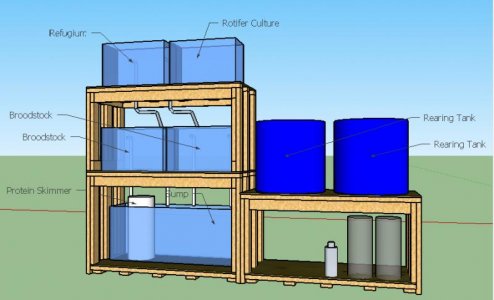RossTheReefer
New member
I've been a reefer for my whole life. My father has had a tank for as long as I can remember. My interest in the hobby has grown from watching his tank when out of town to a fascination that I spend time working on each day. The one tank has now grown into many: a 100 Gallon DT (my father's original tank), 45 Gallon Refugium, 45 Gallon frag tank, 5 Gallon pico tank, 10 gallon hospital tank, 10 gallon rotifer culture and 50 gallon phytoplankton culture.
Eventually I hope to have the experience to successfully breed various dragonet species as the Green Mandarin was my inspiration in getting into breeding. First I have started by learning how to culture live foods for rearing fry. The next step for me is to breed a pair of Banggai Cardinals and a pair of clowns (1 snowflake & 1 ultra snowflake).
I've been working on a plan for my breeding and rearing system, for which I've included a picture. The system contains 4 x 20 gallon high tanks, a 55 sump, and two rearing tanks that are approximately 40 gallons. Two of the 20's will be for breed stock, 1 will be a refugium for biological filtration, and 1 will be a rotifer culture. The refugium will be supplied by a pump in the sump and will overflow into the two brood stock tanks. The rotifer culture will be supplied by a top off pump and will drip into the two rearing tanks. The rearing tanks will be supplied by the sump and also by the roti culture and will drain into the sump. The rearing tanks are 55 gallon drums cut down to 24" high and inside painted black. They will drain and be supplied like this: http://www.aquacare.com/products/fish-farming-tanks/ There will be a protein skimmer on the system and a calcium reactor as well.
Lighting will be small CFLs.
What do you think? Any suggestions on changes to the plan or areas of concern? :fish2:
Eventually I hope to have the experience to successfully breed various dragonet species as the Green Mandarin was my inspiration in getting into breeding. First I have started by learning how to culture live foods for rearing fry. The next step for me is to breed a pair of Banggai Cardinals and a pair of clowns (1 snowflake & 1 ultra snowflake).
I've been working on a plan for my breeding and rearing system, for which I've included a picture. The system contains 4 x 20 gallon high tanks, a 55 sump, and two rearing tanks that are approximately 40 gallons. Two of the 20's will be for breed stock, 1 will be a refugium for biological filtration, and 1 will be a rotifer culture. The refugium will be supplied by a pump in the sump and will overflow into the two brood stock tanks. The rotifer culture will be supplied by a top off pump and will drip into the two rearing tanks. The rearing tanks will be supplied by the sump and also by the roti culture and will drain into the sump. The rearing tanks are 55 gallon drums cut down to 24" high and inside painted black. They will drain and be supplied like this: http://www.aquacare.com/products/fish-farming-tanks/ There will be a protein skimmer on the system and a calcium reactor as well.
Lighting will be small CFLs.
What do you think? Any suggestions on changes to the plan or areas of concern? :fish2:

